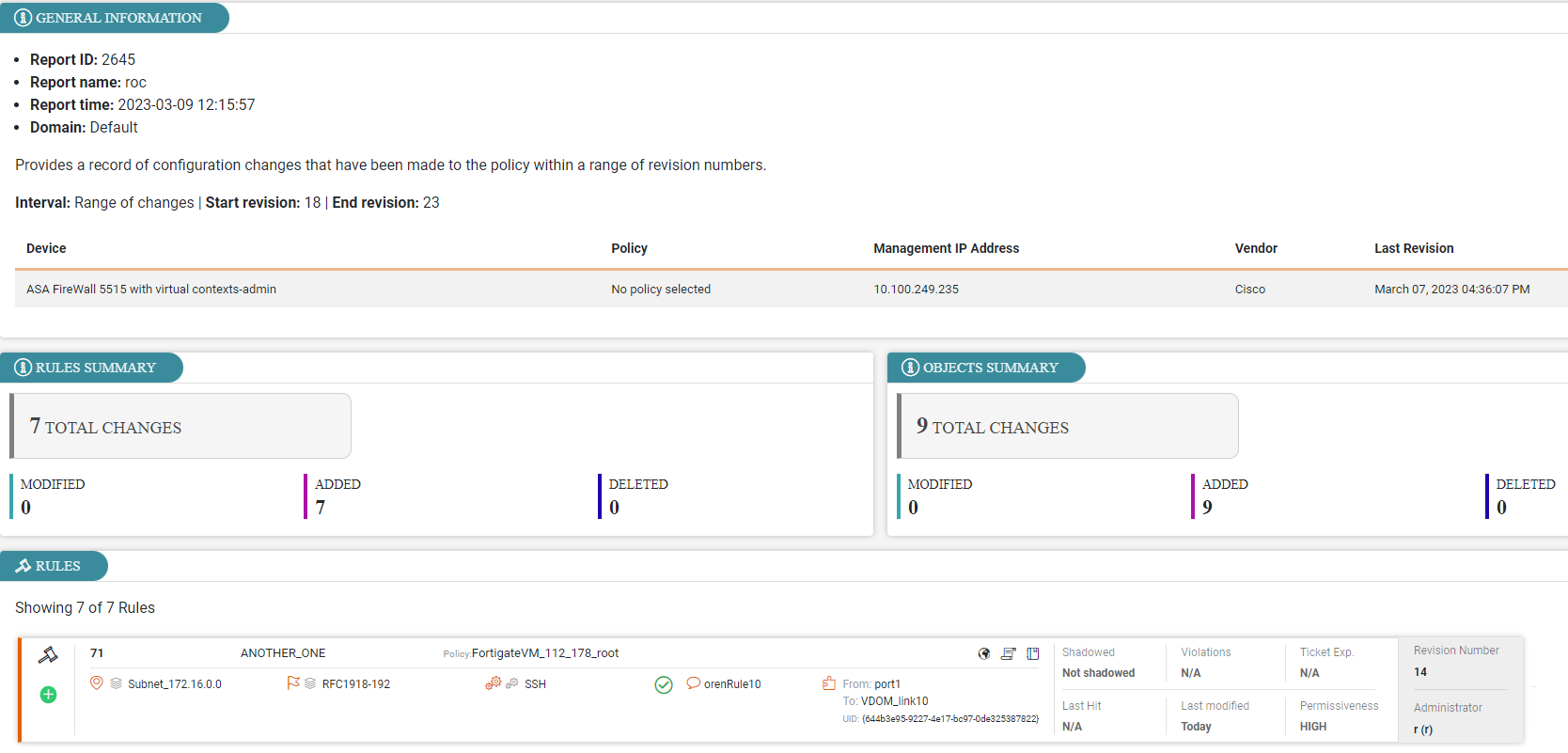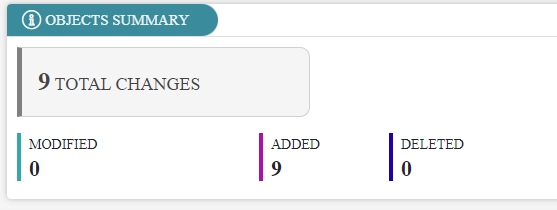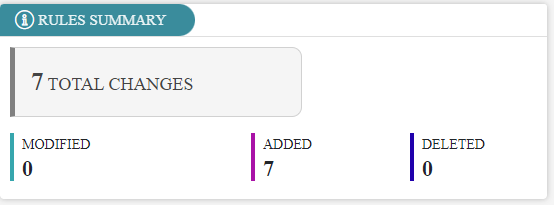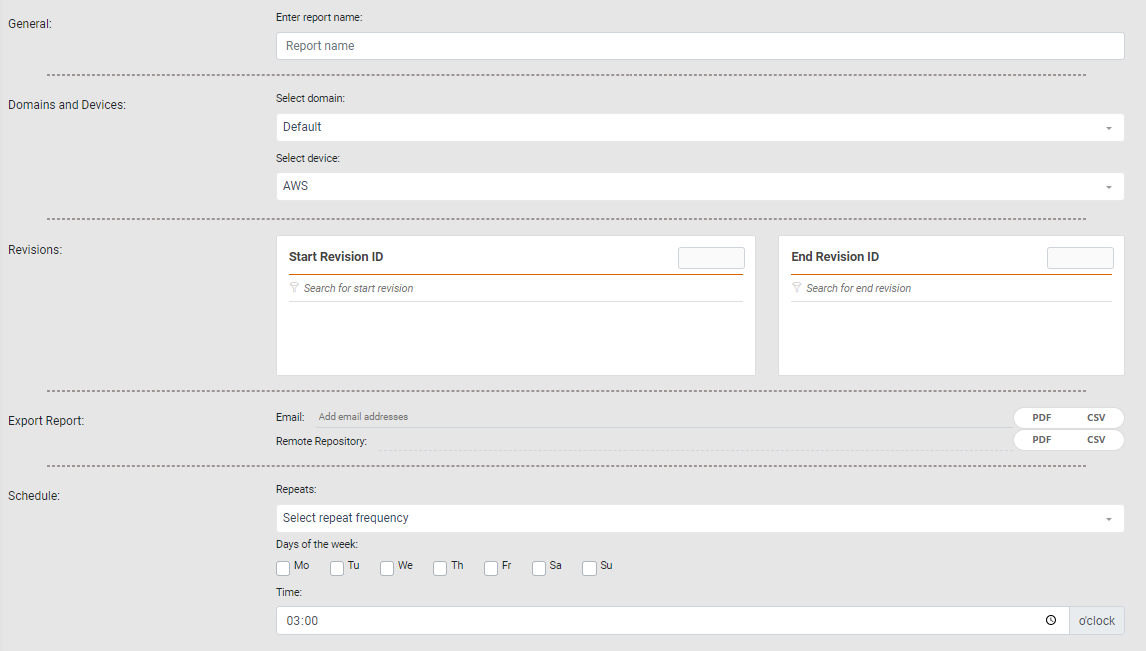On This Page
Rule and Object Changes Report
Overview
The Rule and Object Changes report keeps track of changes that occurred for rules (and their objects) of a given device in a specified time period.
Rule and Object Changes compares each consecutive revision with the previous revision for all the revisions between the starting and ending points, and then lists the added, updated, or deleted rules and objects.
This report enables you to:
-
Easily identify what changes were made to rules and network objects in a defined time-period.
-
Retain change records for audit reporting.
-
Identify SecureTrack users who made changes to rules.
What Can I See Here?
General Information
This section includes information such as report ID, name, time, domain and specific information for the devices that were selected during report creation.
Object Summary
This section show the changes to objects (additions, modifications, deletions).
Rules Summary
This section show the changes to rules (additions, modifications, deletions).
Revision/Administrator
Each rule or object card also includes the Revision Number.
The report output includes three status icons for the rules and objects:
-
 -Added
-Added -
 -Removed
-Removed -
 -Modified
-Modified
For Modified rules, the Changes row highlights the modifications for rule elements. In this example, a destination was added (indicated by a  ).
).
For each rule and object, the Administrator field indicates who made the last change. If the change was not made using SecureChange (change occurred on the device directly), this field will be empty.
Create a Rule and Object Changes Report
Prerequisites
-
In the Settings > General page, the administrator must configure the outgoing SMTP server and the remote repository.
Procedure
-
From the Create (
 ) menu, click Rule and Object Changes.
) menu, click Rule and Object Changes.The Setup page for the report appears.
-
Complete the report fields:
-
General: Report name.
-
Domains and Devices: Select a domain and one or more devices.
-
Revisions: Appears when you select a device.
Select a Start Revision and End Revision.
STRE compares each consecutive revision with the previous revision for all the revisions between the Start Revision date/time and End Revision date/time.
The selected revision number appears in the box in the top-right corner. Use the Search option to find a revision by Revision Number or Date. The format for these search strings is as follows:
Revision Number:
ID: <Revision number>Example:
ID: 249Date:
Date: YYYY-MM-DDExample:
Date: 2002-10-24
-
Export Report:
-
Email: Specify the recipients for notification emails. Press Tab or Enter to separate multiple email addresses.
The email message contains a link to the report in STRE. Reports can be generated as PDF or CSV files, and you can select either option or both (if enabled) to include in the email as an attachment. If the report file is larger than 4 MB, the attachment is compressed as a
.zipfile. -
Remote Repository: STRE can export reports using SFTP. Specify the report format - PDF or CSV.
If the report finished successfully, you can verify that the new files appear in the Reports Folder path, in the remote repository, configured by your administrator (see Send Reports Using SFTP).
-
- Schedule: Configure the following:
- Repeats: Select the frequency by which the report should run. Options include Daily, Weekly, and Monthly.
- Days of the week: Select one or more days on which the report should run.
- Time: Indicate the time at which the report should run.
When scheduling a report to run on a monthly basis, you must choose a single Day of the week value. For whichever weekday you choose (Mon, Tues, Wed, etc.) the report will run on the first of that day every month. Keep in mind, this may not correlate with the first calendar day of that month.
Daily: First and last revisions in the last 24 hours
Weekly: First and last revisions for the last seven days
Monthly: First and last revisions for the last 30 days
For scheduled revisions, STRE calculates the Start and End revisions based on the schedule Repeats setting: -
-
Click one of the following:
 : Saves the report. The Saved menu lists all saved and scheduled reports.
: Saves the report. The Saved menu lists all saved and scheduled reports. : Runs the report. After a report runs, you can view the results in the Repo menu.
: Runs the report. After a report runs, you can view the results in the Repo menu.
Available Report Formats
When viewing the report output, use the Export menu to save the report data.
You can save the data for this report as a CSV file or PDF file. The PDF file shows the first 250 rules and the first 250 objects. The CSV files includes all rules and objects. The CSV export option is useful when you want to create your own reports based on the specific data from the report configuration.










